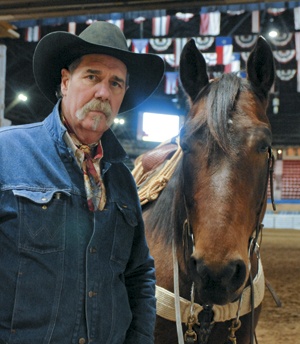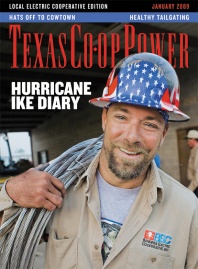With 113 years under its saddle-tooled belt, the Fort Worth Stock Show and Rodeo is a big part of Cowtown’s past. Less obvious, though, is how deeply the show is rooted in the lives of many present-day participants, the people you bump into as you wander among the yellow-brick barns or knock on the doors of the rodeo caravan trailers parked behind the Will Rogers Memorial Coliseum.
From the cattle and swine barns, to the rodeo arena, to the exhibits hall and executive offices, the 24-day event—scheduled from January 16 through February 8—is filled with people whose attachments go back years, often decades.
“It’s like being married to the Mafia. Once you’re in you never get out,” joked Paul Riggs, who manages a string of 64 flashy and pampered saddle horses ridden by flag carriers, dignitaries, pickup riders and others during the show’s 30 performances of professional rodeo and six nights of other rough stock riding and specialty rodeo events.
Oldest in the Nation
Oldest in the Nation
Begun in 1896 when a group of North Texas cattle raisers got together for a one-day event on the banks of Marine Creek near the city stockyards, the Fort Worth stock show is the oldest in the nation, although not the largest. That distinction belongs to Houston.
The Fort Worth show has been interested from the start in attracting a crowd with the latest and newest. The Texas Fat Stock Show, as it was first named, brought in a Wild West show in 1916 and two years later held the nation’s first indoor rodeo. Show promoters named it with the word that Mexican vaqueros used for cowboy contests—ro-DAY-o—and are said to be the first to have Americanized the pronunciation to ro-dee-o. The first one featured junior steer riding and bronc riding for ladies and men, with contestants vying for a total purse of $3,000. An estimated 23,000 people saw the inaugural rodeo’s 12 performances.
Over the years, stock show boosters introduced the first bull-riding contest and side-release chutes, the first live radio broadcast of a rodeo in 1932, the first rodeo to include an entertainer (cowboy singer Gene Autry in 1944), and the first live national television coverage in 1958. That TV broadcast, featuring performances by Roy Rogers and Dale Evans, as well as George “Gabby” Hayes, drew an audience of 8 million viewers.
The broadcast is one of stock show chairman Ed Bass’ earliest memories of the event. “Having spent the previous nine days at the stock show with real cowboys and cattlemen, I sure thought those guys (performers) were some kind of Hollywood dudes,” said Bass, who has been chairman since 2001 and is not exaggerating when he describes the post as “for life.”
Bass, an oil and gas heir who, along with other members of his family, has been instrumental in revitalizing the city’s downtown and cultural district, has long ridden in the show’s horse-powered opening day parade and attends every rodeo performance. He judges every one of its 30 calf scrambles and shakes hands and poses for photographs with each of the 240 winners. “How many other rodeo or stock show chairmen in America can say that?” he asks.
‘We Like Being Cowboys’
‘We Like Being Cowboys’
Riggs’ history with the Fort Worth event also goes way back. He and his wife, Sherry, met at the show in 1973, and he bought their wedding rings at a jewelry store downtown with winnings from a wild horse-riding event the following year. An integral part of the rodeo’s backstage operations, the couple and their cow dog, Lulu, live through the run of the show in their voluminous horse trailer, which last year was set between Punkintown the rodeo clown’s trailer, and another used by Whiplash the border collie-riding monkey. During the rodeo, the Riggses convert their trailer into living quarters—an office and a bedroom.
Sherry and the Riggses’ two daughters have all ridden in the show’s grand entry, during which 12 palominos thunder into the darkened arena carrying cowgirls and the six flags of Texas.
Paul Riggs, who goes to work in spurs, and his crew of 15 are busy from the 7 a.m. horse feeding until well past 10 p.m., when the evening show ends and the “hot” horses are walked, brushed and put up in stalls behind the arena.
“Nobody’s making Silicon Valley money here,” the 54-year-old Riggs said, explaining how his crews eat from a camp grill and bunk in two cramped dressing rooms under the arena. “We’re here because we like being cowboys.”
During the day, and between afternoon and evening performances, his guys help load and unload some of the 750 bucking horses, 450 bulls and more than 600 roping cattle that are used in the rodeo, the fresh stock trucked in twice daily from holding pens in nearby Parker County. During performances, Riggs conducts what he calls “air traffic control” on the horse traffic backstage and tries not to get kicked with all the animals moving around in the cramped alleys.
“I got kicked the other day, full-out double clutch, so this leg is all black, blue and green,” he said. “We get some wrecks out back, not that you’d ever see it in the performance.”
Over in the show barns, 15-year-old Corbin Crenshaw from Levelland described his own longtime connection with perhaps the next-most prominent event, the junior steer show.
“I’ve been competing since I was 9,” said Crenshaw, who likes the stock show best for “all the people here,” including friends from home and—yes, the teenager allows—girls.
His first year in the show ring he was so nervous he couldn’t control his steer, which was disqualified after it got loose three times, he recalls. He has placed high enough every year since to make the show-ending auction, where local businessmen and other show supporters buy the school-aged contestants’ high-placing entries at handsome prices.
Crenshaw’s shorthorn steer, which his younger sister named Mater, fetched $5,000 after placing third in its class.
“I have friends who get mad if they don’t do well, but I’m here for the fun,” said Crenshaw, who is saving his winnings in his college fund. Crenshaw works while he wins money; he helps feed cattle on the family ranch, plus there’s the daily grooming and clipping of his show steer, a ritual that keeps the animal’s coat full and growing.
Crenshaw’s father, Matt Popelka, said he sold some cows at the 2008 show to help pay the bills because showing can get expensive. “There are a lot of cattlemen here, and I like that,” Popelka said, explaining that the show gives him a chance to match his herd against current standards and keep up with the business.
In the exhibits hall, sellers of fencing, livestock chutes, trailers, boots, fudge, fruit, knives, pickup trucks, baseball gloves, tack, saddles, hot tubs, silver jewelry, pots and pans, leather goods, Western art, and front-end loaders vie for attention. Peter Bros. Hats, which has been in business since 1911 on Houston Street in downtown Fort Worth, claims to go back longer than anyone else in the room.
“We started at the 1933 show,” said owner Joe Peters Sr. “Back then, the exhibitors were outside, and my grandfather used to tell me how he’d wrap his feet in rags to try to keep ’em from freezing when the cold weather would blow in.”
Peters, who has been selling hats at the show since 1972, said he’s usually too busy in his booth, which is decorated with some odd-shaped antique hat-making equipment, to do much more than escape to his favorite restaurant on the grounds for some tenderloin tamales.
Always the salesman, Peters said you need not have grown up on a ranch to get in touch with your inner cowhand. “I just finished handling a double order from a Norwegian tourist in a big black duster,” Peters said. “He bought an 1880s-style cowboy hat with a 10-inch crown and a second one just like Garth Brooks’.”
Fort Worth remembers its Western heritage and remains true to its roots primarily because of the stock show, Bass said. “It’s how we teach each generation of kids what the traditions of the American West are all about,” he said. “It’s how I learned and how my daughter has learned to be proud that Fort Worth is known as Cowtown.”
——————–
For more information, go to www.fwssr.com or call (817) 877-2400.
Thomas Korosec is a freelance writer living in Dallas. He attended his first Fort Worth stock show and rodeo in 1985.


